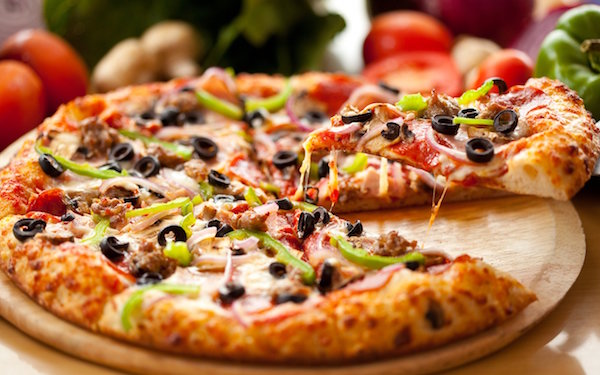
MO'S-PIZZA
Pizza (Italian: [ˈpittsa], Neapolitan: [ˈpittsə]) is a dish of Italian origin consisting of a usually round, flat base of leavened wheat-based dough topped with tomatoes, cheese, and often various other ingredients (such as anchovies, mushrooms, onions, olives, pineapple, meat, etc.), which is then baked at a high temperature, traditionally in a wood-fired oven. A small pizza is sometimes called a pizzetta. A person who makes pizza is known as a pizzaiolo.
Mozzarella cheese is commonly used on pizza, with the buffalo mozzarella produced in the surroundings of Naples. Other cheeses are also used, particularly Italian cheeses including provolone, pecorino romano, ricotta, and scamorza. Less expensive processed cheeses or cheese analogues have been developed for mass-market pizzas to produce desirable qualities like browning, melting, stretchiness, consistent fat and moisture content, and stable shelf life. This quest to create the ideal and economical pizza cheese has involved many studies and experiments analyzing the impact of vegetable oil, manufacturing and culture processes, denatured whey proteins, and other changes in manufacture. In 1997, it was estimated that annual production of pizza cheese was 1 million metric tons (1,100,000 short tons) in the U.S. and 100,000 metric tons (110,000 short tons) in Europe.
Pasta (US: /ˈpɑːstə/, UK: /ˈpæstə/; Italian pronunciation: [ˈpasta]) is a type of food typically made from an unleavened dough of wheat flour mixed with water or eggs, and formed into sheets or other shapes, then cooked by boiling or baking. Rice flour, or legumes such as beans or lentils, are sometimes used in place of wheat flour to yield a different taste and texture, or as a gluten-free alternative. Pasta is a staple food of Italian cuisine.
Pastas are divided into two broad categories: dried (pasta secca) and fresh (pasta fresca). Most dried pasta is produced commercially via an extrusion process, although it can be produced at home. Fresh pasta is traditionally produced by hand, sometimes with the aid of simple machines.Fresh pastas available in grocery stores are produced commercially by large-scale machines.
Pasta is generally served with some type of sauce; the sauce and the type of pasta are usually matched based on consistency and ease of eating. Northern Italian cooking uses less tomato sauce, garlic and herbs, and white sauce is more common. However Italian cuisine is best identified by individual regions. Pasta dishes with lighter use of tomato are found in Trentino-Alto Adige and Emilia Romagna. In Bologna, the meat-based Bolognese sauce incorporates a small amount of tomato concentrate and a green sauce called pesto originates from Genoa. In Central Italy, there are sauces such as tomato sauce, amatriciana, arrabbiata and the egg-based carbonara. Tomato sauces are also present in Southern Italian cuisine, where they originated. In Southern Italy more complex variations include pasta paired with fresh vegetables, olives, capers or seafood. Varieties include puttanesca, pasta alla Norma (tomatoes, eggplant and fresh or baked cheese), pasta con le sarde (fresh sardines, pine nuts, fennel and olive oil), spaghetti aglio, olio e peperoncino (literally with garlic, [olive] oil and hot chili peppers), pasta con i peperoni cruschi (crispy peppers and breadcrumbs).
our menu is one of the best for family or single visitors because it comprises of all the best different types of pizzas, pastas and other items .
